You’ll want cotton buffing wheels because they’re gentle on precious metals and gemstones while delivering professional-quality finishes. Cotton’s soft, breathable fibers prevent scratching and reduce heat buildup that can damage delicate pieces. They’re flexible enough to conform to intricate jewelry curves and work effectively with various polishing compounds. Cotton wheels are also cost-effective, reusable, and safer than abrasive alternatives. Discover how proper selection and maintenance can maximize their polishing potential.
Understanding Cotton Buffing Wheel Composition and Materials
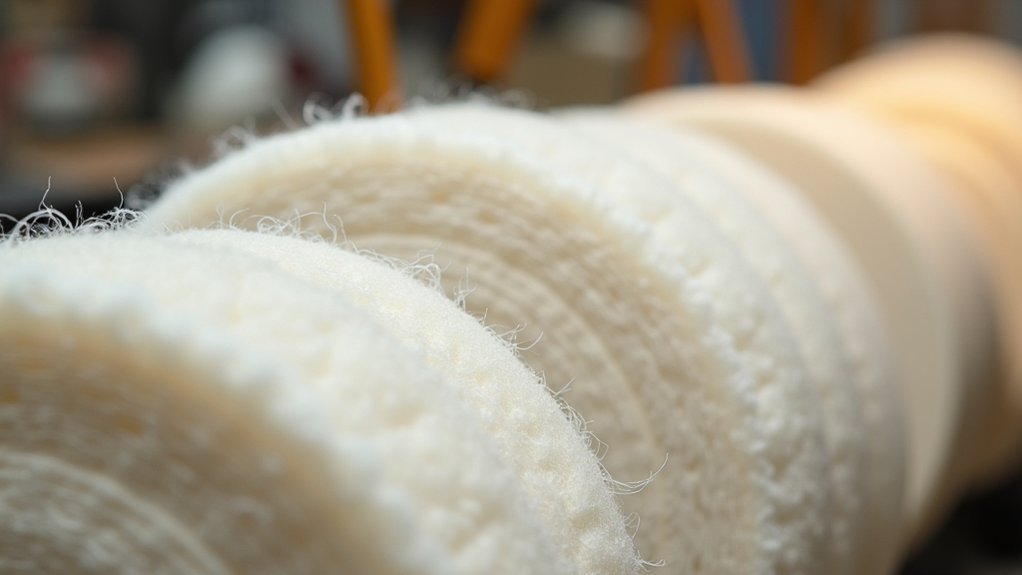
Cotton buffing wheels achieve their polishing effectiveness through their unique construction from premium woven cotton fabric. This lightweight, pliable material allows you to polish effectively without generating excessive heat that could damage your workpiece.
The composition of cotton buffing wheels varies considerably through ply ratings ranging from 20 to 60. Higher ply ratings provide denser, thicker options for more aggressive buffing, while lower ratings offer gentler finishing capabilities.
You’ll find the open weave design enhances breathability, preventing overheating during high-speed operations and extending wheel lifespan.
These versatile tools work with various polishing compounds, enabling you to achieve different finishes on metals and other materials. Whether you’re performing early-stage cutting or final finishing, cotton buffing wheels adapt to your specific polishing requirements through their varied construction options.
Advantages of Cotton Fibers in Jewelry Polishing Applications
When you’re polishing delicate jewelry pieces, cotton fibers provide the gentle surface contact you need to avoid scratching precious metals and gemstones.
The soft, pliable nature of cotton buffing wheels allows you to achieve professional-quality finishes without the aggressive action that can damage intricate designs.
You’ll also benefit from cotton’s natural breathability, which reduces heat buildup during extended polishing sessions and protects your jewelry from thermal damage.
Gentle Surface Contact
While many polishing materials risk damaging delicate jewelry surfaces, cotton buffing wheels deliver exceptionally gentle contact that protects your most precious pieces.
The soft, pliable nature of cotton fibers guarantees you won’t scratch or damage sensitive metals during polishing jewelry applications. You’ll benefit from the lightweight woven structure that prevents overheating, maintaining your metal’s original properties throughout the process.
Cotton’s breathable fibers allow efficient dust removal, creating cleaner working conditions that enhance your final shine.
This versatile use capability means you can rely on the same wheel across multiple polishing stages, from initial cutting to finishing touches.
When you need consistent results without compromising delicate surfaces, cotton buffing wheels provide the perfect balance of effectiveness and protection for your valuable jewelry pieces.
Heat Reduction Benefits
Because excessive heat can warp delicate metals and cause permanent discoloration, you’ll find cotton buffing wheels provide superior thermal management during jewelry polishing operations.
The lightweight woven cotton fabric creates better airflow that considerably reduces heat buildup on jewelry surfaces. You’ll appreciate how the open weave design prevents overheating, making these wheels perfect for delicate metals and intricate pieces that excessive heat could damage.
The breathable nature of cotton fibers dissipates heat more effectively than denser materials, minimizing warping and discoloration risks. You can enjoy gentle polishing that maintains fine jewelry finishes without heat-related damage.
Cotton buffing wheels operate at high speeds without generating excessive frictional heat, ensuring safer and more efficient polishing processes.
Heat Dissipation Properties of Cotton Buffing Wheels
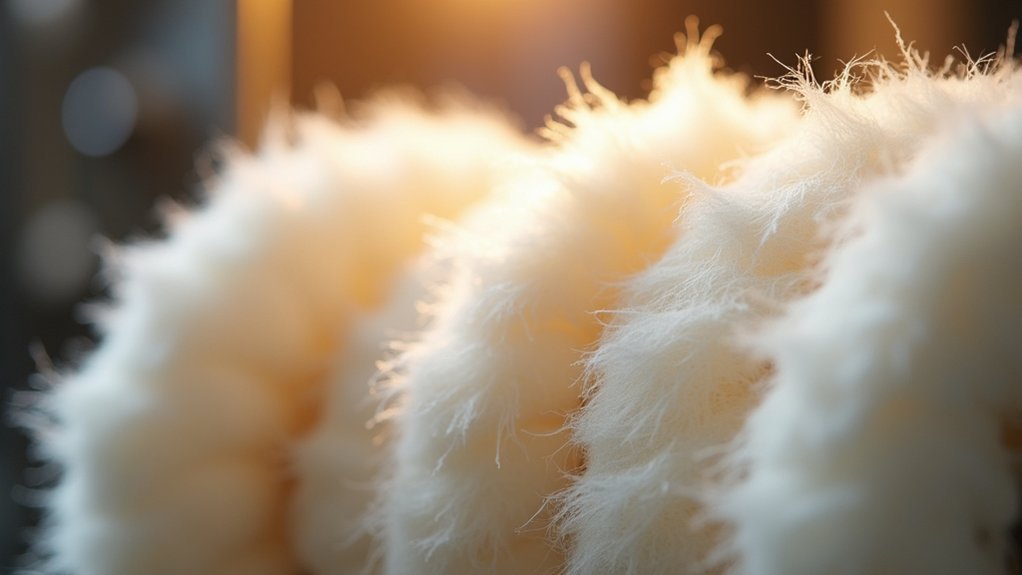
Since cotton buffing wheels feature an open weave design, they naturally promote superior airflow that effectively dissipates heat during polishing operations.
This breathable structure keeps your work surface cooler, preventing warping or damage to delicate finishes. You’ll find that cotton’s lightweight fabric reduces friction considerably, helping minimize heat buildup compared to denser wheel materials.
The superior heat dissipation properties make cotton buffing wheels ideal for high-speed applications up to 1750 RPM.
Cotton buffing wheels excel in high-speed polishing up to 1750 RPM thanks to their exceptional heat management capabilities.
You can tackle continuous polishing tasks without worrying about overheating issues that plague heavier wheels. This thermal management capability protects both your equipment and workpiece, ensuring consistent results throughout the polishing process while extending the life of your buffing wheel investment.
Compatibility With Different Polishing Compounds and Rouge
You’ll find that cotton buffing wheels excel at holding and distributing various polishing compounds due to their natural fiber structure.
The way you apply rouge to these wheels considerably impacts your polishing results, with proper loading techniques ensuring even compound distribution across the wheel’s surface.
Cotton’s absorbent properties allow it to retain compounds effectively while releasing them gradually during the buffing process, giving you consistent polishing action throughout your work.
Rouge Application Techniques
Mastery of rouge application transforms cotton buffing wheels into precision polishing tools that deliver professional-grade results across diverse metalworking projects. Your application techniques directly impact finish quality and wheel performance. Apply polishing compounds evenly across the wheel’s surface while it’s spinning at moderate speed. Don’t overload cotton buffs with buffing rouges – light, consistent coating works best. For final polishing, pair loose cotton wheels with white rouge using gentle pressure. When working with stitched cotton wheels, green or red compounds require firmer application for effective cutting action. Prevent cross-contamination by dedicating specific wheels to individual rouge types. This practice maintains compound purity and guarantees consistent results across different metals and finishing stages.
| Rouge Type | Cotton Wheel | Application Method | Pressure Level | Best For |
|---|---|---|---|---|
| White | Loose Cotton | Light coating | Gentle | Final polish |
| Green | Stitched Cotton | Moderate coating | Medium | Cutting metals |
| Red | Stitched Cotton | Even application | Firm | Heavy polishing |
| Blue | Medium Cotton | Sparse coating | Light | Stainless steel |
| Brown | High-ply Cotton | Thick application | Heavy | Rough finishing |
Compound Absorption Properties
When you select cotton buffing wheels based on their compound absorption properties, you’re leveraging one of cotton’s most valuable characteristics for professional polishing.
Muslin cotton wheels excel at absorbing and retaining polishing compounds, creating superior application during your polishing process. The open weave design guarantees consistent compound distribution across surfaces you’re working on.
You’ll find that ply rating directly impacts absorption capacity – higher ply counts from 20 to 60 provide greater compound retention for more efficient polishing.
Combed cotton buffs work perfectly for final polishing since they hold compounds exceptionally well.
Cotton buffing wheels demonstrate remarkable compatibility with various compounds, from Tripoli for cutting to rouge for finishing, enabling you to achieve diverse surface finishes with consistent, professional results.
Cotton Wheel Flexibility for Intricate Jewelry Details
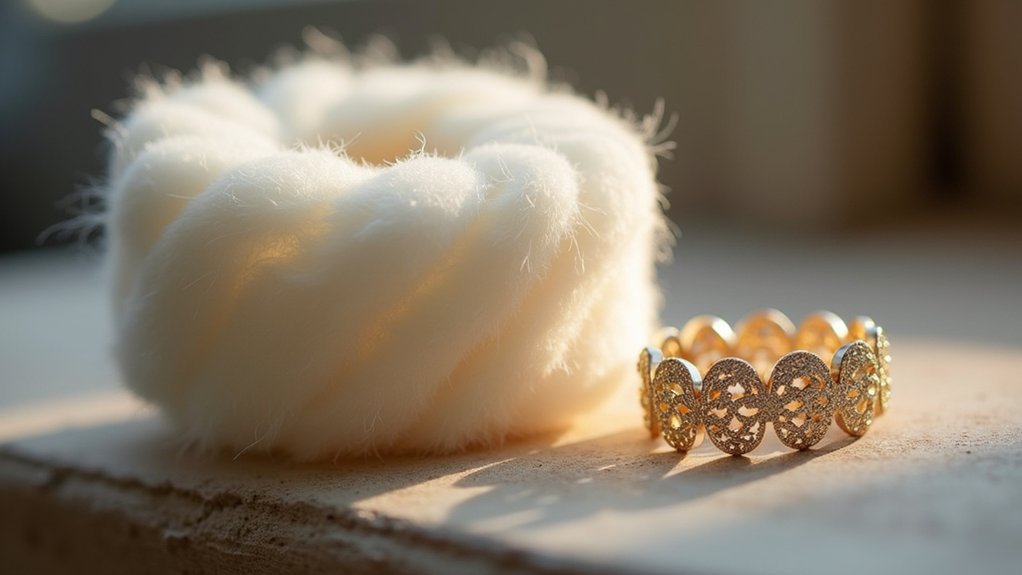
Since jewelry often features delicate curves, tight corners, and intricate patterns, you need polishing wheels that can adapt to these complex surfaces without causing damage.
Cotton buffing wheels excel in this area due to their exceptional flexibility. The soft, pliable nature of cotton allows these wheels to conform seamlessly to intricate shapes, ensuring every surface receives proper attention during polishing.
You’ll find that cotton’s natural flexibility enables the wheel to bend and compress into crevices and contours that rigid materials simply can’t reach.
This adaptability is vital when working with jewelry pieces featuring detailed engravings, filigree work, or complex geometric designs. The result is a consistently high polish across all surfaces, including those hard-to-access areas where other polishing methods might fall short.
Durability and Longevity of Cotton Buffing Wheels
Beyond their adaptable nature, cotton buffing wheels offer remarkable durability that makes them a smart investment for your polishing operations. You’ll find their strong, resilient fabric withstands repeated use without significant wear, while the breathable material reduces heat buildup that can damage wheels.
The ply rating directly impacts longevity – higher ratings mean more layers and extended lifespan for your polishing sessions.
| Ply Rating | Thickness Level | Expected Durability |
|---|---|---|
| 20-30 | Light | Moderate use |
| 31-45 | Medium | Extended sessions |
| 46-60 | Heavy | Maximum longevity |
| Custom | Variable | Specific applications |
| Premium | Extra Heavy | Professional grade |
Cotton’s soft texture conforms to surfaces for effective polishing while minimizing damage risk. With proper maintenance like cleaning and storage, you’ll maximize their cost-effectiveness across diverse applications.
Cost-Effectiveness Compared to Alternative Wheel Materials
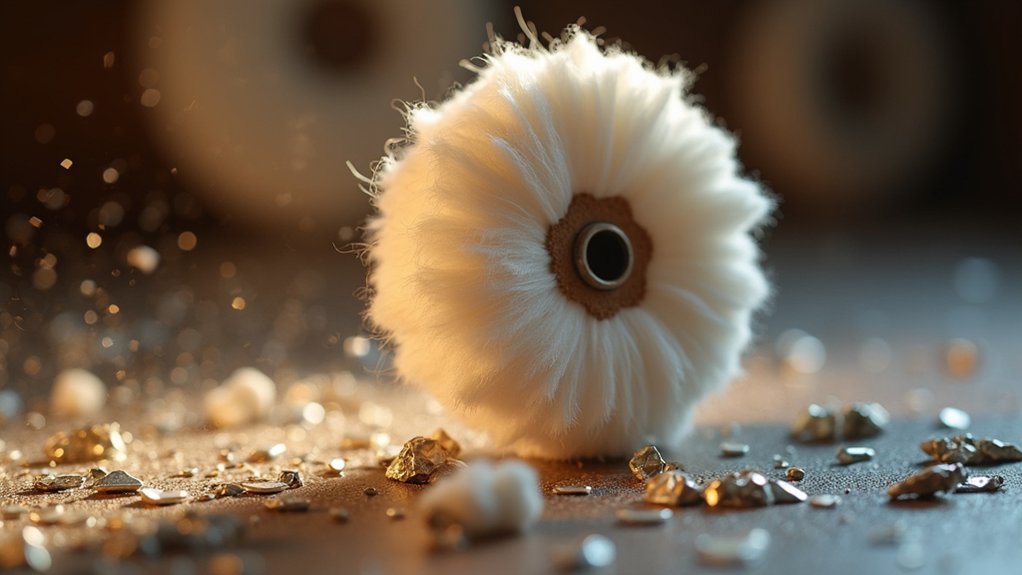
While synthetic alternatives may seem appealing, cotton buffing wheels consistently deliver superior value for your polishing budget. You’ll find these wheels considerably less expensive than synthetic options while maintaining comparable performance levels. The variety of ply ratings available lets you select the perfect thickness without breaking your budget.
Cotton buffing wheels offer exceptional cost-effectiveness through their reusable nature. You can clean and maintain them multiple times, unlike disposable alternatives that drain your wallet. This makes them an economical option for both hobbyists and professionals seeking reliable polishing solutions.
Investing in cotton wheels saves money long-term since they handle diverse materials and applications effectively. You won’t need multiple specialized wheels, reducing equipment costs while achieving professional-quality finishes across various projects.
Safety Benefits of Using Cotton Over Abrasive Wheels
When you’re polishing valuable pieces, you’ll appreciate how cotton buffing wheels generate considerably less heat than abrasive alternatives, preventing thermal damage to your workpiece.
You won’t have to worry about burns or warping since cotton operates at cooler temperatures throughout extended polishing sessions.
The gentler surface contact means you can work with confidence, knowing you’re minimizing the risk of scratches, gouges, or other surface damage that harder wheels often cause.
Reduced Heat Generation
As you polish with cotton buffing wheels, you’ll notice considerably less heat buildup compared to abrasive alternatives. This reduced heat generation stems from cotton’s breathable fabric structure, which promotes air circulation and prevents thermal buildup during the polishing process. You’ll experience a gentler polishing action that protects sensitive materials from damage or distortion.
| Cotton Wheels | Abrasive Wheels |
|---|---|
| Cool, comfortable operation | Excessive heat generation |
| Protected workpiece integrity | Risk of material warping |
| Extended wheel lifespan | Premature wear and failure |
| Enhanced safety for operators | Burn hazards during use |
The softer composition minimizes friction while maintaining effective polishing results. This combination of reduced heat generation and improved safety makes cotton buffing wheels your smartest choice for professional finishing work.
Gentler Surface Contact
Because cotton buffing wheels feature a soft, pliable composition, they deliver remarkably gentler surface contact than their abrasive counterparts. You’ll find they’re perfect for polishing delicate surfaces without risking scratches or damage that harder wheels often cause.
Their forgiving nature helps minimize overheating and warping, protecting your materials’ integrity throughout the process. Unlike aggressive abrasive options, cotton buffing wheels conform beautifully to intricate shapes and contours, ensuring you achieve a smooth finish every time.
You’ll appreciate how they prevent excessive material removal, giving you controlled polishing that’s ideal for high-shine results. This gentler approach means you can work confidently on softer metals like aluminum and brass, knowing you’ll maintain the underlying surface’s quality while achieving professional-grade results.
Achieving Professional-Grade Finish Quality With Cotton Wheels

While achieving a mirror-like finish requires precision and technique, cotton buffing wheels provide the perfect foundation for professional-grade results.
You’ll find their soft, pliable construction delivers that coveted high-gloss finish without surface damage. The key lies in utilizing polishing compounds like rouge, Tripoli, and emery through multi-stage polishing processes that progressively refine your workpiece.
Cotton’s inherent flexibility allows you to tackle irregular shapes and complex contours with consistent results. You can start with aggressive cutting compounds on higher-ply wheels, then shift to finer polishing compounds on lighter wheels.
This systematic approach guarantees you’re removing scratches while building up that professional-grade finish. The breathable cotton weave prevents heat buildup, protecting both your material and maintaining compound effectiveness throughout the polishing sequence.
Maintenance and Care Requirements for Cotton Buffing Wheels
Professional-grade results depend not only on technique but on properly maintained equipment. Your cotton buffing wheels require consistent maintenance to deliver peak performance and safety.
Regular inspection for wear and damage prevents accidents while ensuring quality results.
Essential maintenance practices include:
- Cleaning after each use – Remove polishing compounds to prevent cross-contamination that affects finishing quality
- Proper storage – Keep wheels in dry, dust-free environments to prolong lifespan and maintain effectiveness
- Using spurs for revitalizing – Clean and restore surface buffing efficiency to extend usability
Maintaining the softness of your cotton buffing wheels requires avoiding excessive pressure during operation.
Allow wheels to run at designated RPM without overloading. This careful approach preserves their shape and effectiveness for consistent, professional results.
Selecting the Right Cotton Wheel Configuration for Your Projects
When you’re selecting cotton buffing wheels, the configuration you choose directly impacts your polishing results. You’ll need to match the wheel type to your project’s stage and requirements.
| Configuration | Best Use |
|---|---|
| Loose cotton buffs | Late-stage finishing with fine compounds |
| Spiral sewn buffs | Earlier polishing stages with coarser grits |
| Higher ply rating (40-60) | Larger surfaces, efficient buffing |
Consider your ply rating carefully—lower counts (20-30) work better for tight areas and small jobs. The cotton material’s lightweight woven fabric provides essential breathability during high-speed operations, preventing overheating.
Proper wheel size matters too. Choose from 4 to 10-inch diameters based on your surface area and project intricacy. Match your polishing compound to the configuration for best performance.
Frequently Asked Questions
What Is the Best Material for Buffing Wheels?
You’ll find cotton’s the best material for buffing wheels because it’s soft, breathable, and won’t overheat surfaces. It’s lightweight, versatile across metals and plastics, and available in various densities for different polishing stages.
What Is the Difference Between a Spiral and Loose Cotton Buffing Wheel?
You’ll find spiral cotton wheels are denser and more aggressive for early polishing stages, while loose cotton wheels fan out wider, generating less heat for gentler finishing work.
What Is a Cotton Buffing Pad Used For?
You’ll use cotton buffing pads for final polishing to achieve high-gloss finishes on metals and other materials. They’re perfect for applying buffing compounds like rouge and handling both light finishing and heavy-duty polishing tasks.
What Is a Denim Buffing Wheel Used For?
You’ll use denim buffing wheels for polishing and finishing metal surfaces like brass, copper, and aluminum. They’re denser than cotton buffs, providing aggressive cutting while creating satin finishes with subdued gloss.
In Summary
You’ll find cotton buffing wheels deliver unmatched versatility for your polishing projects. They’re gentle enough for delicate jewelry work yet effective for professional-grade finishes. You’ll appreciate their superior heat dissipation, compound compatibility, and flexibility around intricate details. They’re safer than abrasive alternatives and require minimal maintenance when properly cared for. By selecting the right cotton wheel configuration, you’ll achieve consistently excellent results while protecting both your workpieces and workspace safety.

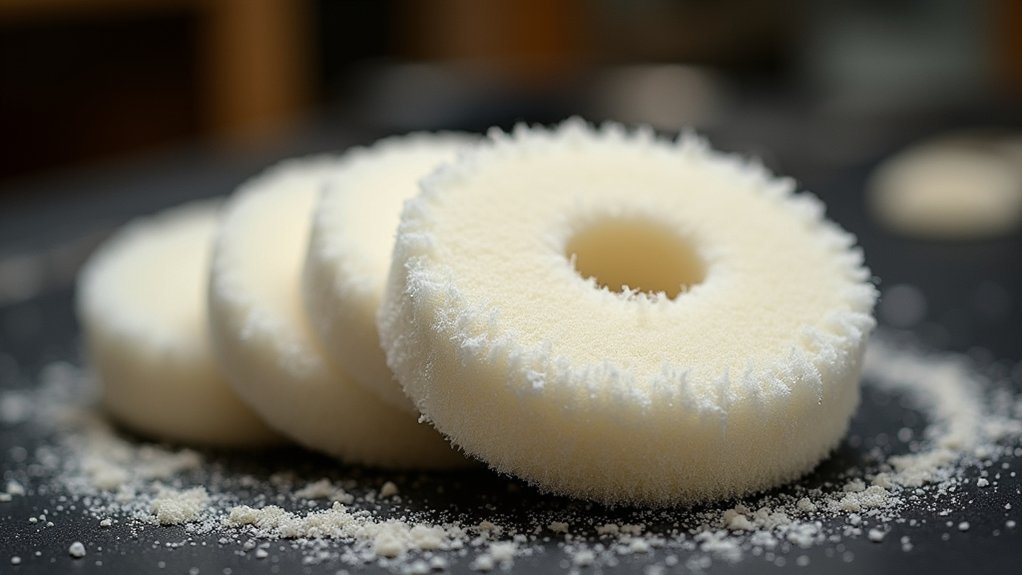



Leave a Reply